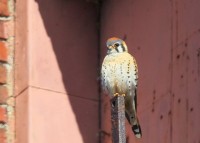American Kestrel male
July 17, 2014 in American Kestrel
July 17, 2014 in American Kestrel
July 7, 2014 in American Kestrel
April 28, 2014 in American Kestrel
 The Kestrels have returned again to Lawrence for another breeding season! Today was the first sighting of a male kestrel near the Duck Bridge along the Merrimack River.
The Kestrels have returned again to Lawrence for another breeding season! Today was the first sighting of a male kestrel near the Duck Bridge along the Merrimack River.
According to Mass Audubon, the adult male, which has blue wings, two sharp, vertical, black stripes contrasting against a light face, and a bright rufous tail, is certainly the most colorful of North American hawks. The somewhat larger female is not as brilliant as the male and has its upperparts entirely rufous, and barred with black. Kestrels tend to perch high and conspicuously in the open, making them easily visible. They can be tamed readily and will reproduce in confinement. Many falconers have noted that the small males are more docile and tractable than the females.
Spring migration occurs mainly during March and April, and by the latter month local breeders are on their territories at woodland borders, fields, pastures, and the edges of highways. As the breeding season approaches, kestrels abandon their solitary winter habits. Members of a pair often perch side by side, and courtship consists of aerial displays by the male above a perched or flying female. The male ascends on rapidly fluttering wings and then plunges steeply, giving the familiar, repetitive killy-killy or kee-kee call, which is used not only in courtship but also at other times of excitement. Copulation during this period is frequent and precedes egg laying by several weeks.